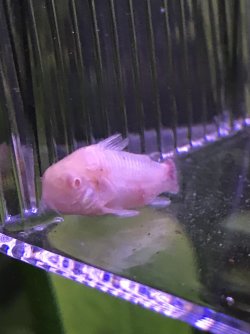Update:
I did a 25% water change to help dilute some of the salt, but I didn't really notice any difference with my items of concern. I planned on doing a bigger, routine water change this weekend, anyway, as the weekends are when I do big water changes normally. So I might go ahead and do that on Sunday. Should I add aquarium salt to the new water at that time? Or do you think the one dose of salt was enough, and I can just proceed to use heat for the second week?
The white spots are even less, now. I only see one white spot on one fish now. And it's not one of the 2 fish I originally noticed the parasite on. It's one of the later infected fish. It only developed this one spot, not several like the fish infected earlier. So I can see the treatment is working.
The one suddenly antisocial betta is still being antisocial and hiding, and not eating. I'll continue to monitor her. She might be eating when I'm not looking, but I doubt it, as I can see she's starting to get thinner. The thing is, she's acting just like Lucy did before she died. In the days leading up to Lucy's death, she was doing the exact same things... hiding alone in dark cavernous areas of the tank, not coming out right away during feeding, not eating with the other fish during feeding, not socializing with the other bettas. The behavior is very much the same. Lucy died last week, 12 days after introducing the sorority to the tank. I assumed she was bullied to death for her size, even though I never saw any bullying, just because of how she was hiding all the time. But now Roseanne is doing it, too, and she's the same size as the others, not smaller like Lucy was. So maybe it wasn't bullying that killed Lucy after all, maybe it was ich. I never saw white spots on her, though. As I said, I didn't see any white spots on any fish until the day after the big rearrange.
Post Treatment Changes:
I've been noticing small (very very small) nips on some of the bettas' fins. I assumed that happened while they were establishing a pecking order, but now I'm seeing nips on the corys fins too. The dorsal fin on one of the corys is almost completely gone. From what I can see, these don't look anything like fin rot, they look like the result of fin ninpping. I don't think my bettas are responsible, though. I think it's the neon tetras. I have 11 of them.
So, after the ich is gone, I think I want to move the neons to another tank. I'm thinking a 10 or 15 gallon tank. Maybe 20 gallons. I haven't decided yet. I need to purchase a tank and start cycling it with seeded media soon, though, as I want to move them sooner rather than later. As for tank mates, I think I want to do a second tetra species, or maybe even a third. Basically just have a tetra-only tank. I know each tetra species will need its own shoal. What other tetra species go well with neons? I've had my eye on red eye tetras, black neons, and blind cave fish, but IDK about compatibility with neons or different water requirements. I definitely want a small tank with 2 or 3 different shoals in it (one of the shoals being my 11 neons, of course), the smallest tank I can reasonably have that many fish in without overcrowding.
That will leave this tank with the sorority, kuhli loaches, corydoras, shrimp, and a snail, and will relieve some of the bioload so I can maybe add more bettas. I have 2 female bettas not yet in this tank, a crowntail juvenile, and a white elephant ear. The crowntail is in her juvie tank, until she grows, and the elephant ear is in QT. The elephant ear is about the same size Lucy was, though, so I might want to give her some time to grow too. I initially passed on her, because of her size, but 2 weeks later she was still sitting on the shelf at Petco, and I couldn't get her out of my head since first seeing her, so I took her home.
After removing the tetras, I may want another peaceful shoaling mid-level fish to replace them in this tank. Just maybe in a smaller number than 11 since I plan on adding more bettas. Any recommendations? What about harlequin rasboras?
My PH is around 7.6, and I have pretty hard water.
Again, I'm not going to do any of these changes until ich treatment is done and over with and I'm absolutely certain the parasite is gone. I don't want to infect more tanks or fish.




